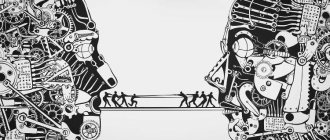What is kinesics
What is kinesics? This is a science that studies the role of gestures, facial expressions, body movements and other non-verbal manifestations in the process of communication. Some of the first studies of kinesics were carried out by Charles Darwin in his work on the expression of emotions in animals and humans. The concept of “kinesics” was first used by R. Birdwhistell in 1952.
Unlike speech, kinetic manifestations are not so much subject to volitional control. Often they can provide even more information than words. Gestures and facial expressions allow a person to more accurately convey to the interlocutor the meaning of what was said, express his attitude to the information, and reveal details in detail. The listening person, using non-verbal means, reads additional information, can distinguish truth from lies, and can also simply support the speaker and show his concentration on him, for example, by nodding his head or facial expressions.
The importance of nonverbal cues
According to the Austrian writer Alan Pia, which can be found in his famous book “The Language of Movements,” a person perceives only 7% of verbal information. The remaining 93% comes to us through non-verbal signals. The latter method of communication is better known as sign language. It means a form of self-expression in which a person does not utter words or use any of the symbols of speech.
Knowing nonverbal cues in communication becomes important for several reasons. First of all, sign language is entrusted with the function of expressing the feelings that have arisen as accurately as possible. After all, they are often so complex that the selection of words to describe them is simply impossible. This can only be done using non-verbal means and methods. In addition, sign language is necessary for deeper mutual understanding between interlocutors.
Facial expressions
Facial expressions are various movements of the facial muscles and their combinations. It is quite weak to control; it is not always possible to restrain an impending smile or frowning eyebrows. With the help of facial expressions, a person can express a whole range of emotions without words: sadness, anger, joy, tenderness, surprise, delight, disappointment, bewilderment and others. More than other parts of the face, the eyebrows and mouth are involved in facial expressions.
There are people with well-developed ability to control their own facial muscles. It is sometimes not possible to correctly recognize their emotions or the veracity of information. They can enhance facial expressions or, conversely, restrain them. However, it is not always possible to completely control these processes during a conversation, so it is necessary to constantly compare the words and facial expressions of such people.
How are feelings different from emotions?
Close in meaning, but still not identical, are the concepts of emotions and feelings. In scientific psychology, these terms define different components of a single emotional background.
Feelings are deeper states that determine a person’s stable attitude to surrounding events. They are often less pronounced and have smoothed manifestations. Emotions are a reaction-outburst to a specific situation, causing vivid manifestations, often born unconsciously. In psychology, feelings are more conscious manifestations of attitudes towards a particular object. A person can experience the whole gamut of emotions, but at the same time not show feelings if there are no prerequisites for this. For example, do not hate an enemy if the enemy does not exist. At the same time, show anger if something served as a reason for this.
Types of feelings
In fact, this part of the perception of the environment is difficult to classify, since it is multifaceted and diverse. Conventionally, psychology defines the following types of feelings:
- moral;
- intellectual;
- practical;
- aesthetic.
| Category | Subcategory | Manifestations | Characteristic |
| Moral | Moral | Humanity | Relationships between people, attitudes towards one’s own position in society, determination of acceptable behavior, the limits of what is permitted. |
| Patriotism | |||
| Call of Duty | |||
| Love | |||
| Immoral | Cruelty | ||
| Selfishness | |||
| Hatred | |||
| Greed | |||
| Intelligent | Specific | Inspiration | Determine attitude to intellectual needs. |
| Determination | |||
| Thirst for knowledge | |||
| Satisfaction from new knowledge and discoveries | |||
| Nonspecific | Curiosity | ||
| Astonishment | |||
| Humor | |||
| Irony | |||
| Praxic | Choice of activity | Profession | They determine the attitude towards everyday worries, responsibilities, and relationships with society. |
| Favorite leisure activity | |||
| Interesting activities | |||
| Aesthetic | Satisfaction from seeing, touching, listening | Love for nature | Determine the range of interests aimed at satisfying aesthetic needs |
| Love for technology | |||
| Favorite music | |||
| Works of art, architecture, sculpture |
There are more complex feelings that cannot be clearly attributed to one of the types. For example, love awakens a person to strive for knowledge, to reveal aesthetic potential, inspires, and determines the choice of activity.
Sight
Gaze and eye contact with the interlocutor play a huge role in communication. With just your eyes you can express contempt or respect, interest in a conversation or boredom, confidence or shyness. Even the pupils can provide information about a person at a given moment. Dilated pupils often mean emotional excitement and a positive mood, while constricted pupils indicate uncertainty or a bad mood.
The frequency and duration of eye contact also matters. A self-confident person can communicate without almost taking his eyes off the interlocutor. Also, long-term eye contact is established between well-known and close people with whom you can be frank. Jerky glances, lowering the eyes to the floor or constantly looking them to the side can indicate a person’s lack of confidence in himself or in the information he is giving out. Lies, lack of emotional contact with the interlocutor and reluctance to talk are also manifested in a similar way.
Differences in the nature of the gaze.
Gaze duration is a major cross-national difference. Southern Europeans, such as the Spaniards and Italians, consider it completely natural to stare long and straight, while northern Europeans, such as the English or Germans, consider such behavior to be unceremonious and even insulting. In these countries, it is not customary to openly examine the people around you and look long and intently into the eyes of your interlocutor. For the Japanese, direct gaze is considered completely unacceptable. When communicating with an interlocutor, they look at the neck area; men do not look women in the eyes and vice versa. Because of this, when a European talks to a Japanese, the former has a feeling of lack of contact. And the Japanese feel extremely uncomfortable when a European looks him in the eye. If you do not take into account such cultural characteristics when communicating with representatives of other nationalities, then it is likely to cause mutual irritation, possibly even hostility, which will not have the best effect on further interactions (if any are envisaged)
Gestures
Gestures are voluntary and involuntary movements of the hands and head during communication. Gestures can say a lot about a person himself. Active movements are usually characteristic of people with an extroverted personality, with a sanguine or choleric temperament, a high level of self-confidence and good self-esteem. Individuals with an introverted personality, melancholic, phlegmatic, and insecure people usually display a rather meager range of gestures.
Movements of the head and hands also say a lot about the current state of a person. The more active the gestures, the more interested the person is in the conversation and in being heard. Very weak or absent gestures often indicate that the person is not interested in the conversation. It may also indicate an attempt to deceive the interlocutor.
Three main groups of gestures can be distinguished:
- Communicative. Used in any type of communication, they usually accompany greetings, farewells, and attempts to attract attention to oneself. Examples include shaking or waving your hand.
- Modal. With their help, a person expresses his attitude to the information spoken or heard. For example, nodding your head as a sign of approval or turning away, indicating reluctance to continue the conversation.
- Descriptive. These are gestures that have meaning in the context of the actual conversation. For example, a person uses gestures to show the size of a caught fish or uses them to describe the layout of his house under construction.
It is worth understanding that in different peoples and cultures, gestures can differ and even be opposite. For example, a simple nod of the head means agreement in some countries, and denial in others. Another example is twisting your finger at your temple. In Russia it is interpreted as stupidity, in India as a sign of respect, and in Holland as an indicator of high wit.
Common Gestures
Gestures may vary in meaning from person to person, but there are generally accepted movements that are very common in communication. These include, for example, the following manifestations:
- a person touches or scratches his ears as a sign that he does not like the information he hears;
- rubs his chin – he feels bored and lacks interest;
- strokes his chin - reflects and ponders;
- taps his fingers and constantly glances at the clock - he is in a hurry, nervous or impatient;
- crosses his arms over his chest - most likely, does not want to talk;
- rubs his neck - not sure of the information said or heard;
- puts his hands behind his head or behind his back - trying to demonstrate his superiority over his interlocutor;
- covers his mouth - he is hiding something or is not saying something, perhaps he is providing deliberately false information.
Modern approaches
The approaches of foreign researchers have changed over time. The study has become more systematic, focusing on the public, in-group behavior and interactivity, and the understanding that nonverbal cues can have multiple purposes and meanings. Modern approaches include defining gestures, facial expressions, and other elements of nonverbal communication as: Emblems—movements or gestures of the body that directly translate into a word or phrase; Illustrators are gestures that accompany or enhance verbal messages; oPointers - gestures that accent or emphasize words or phrases; oIdeographs are gestures that allow you to track the cause-and-effect relationship of a message; o Action movements - point to a real object in space; oKinetographs - depict body movement; oSpatial movements - highlight spatial relationships; oPictograms - draw a picture related to the replica object; oRhythmic movements - adjust the rhythm of the message or the rhythm of the event; Affective movements - show emotions; Regulators - control the flow and pace of communication; Manipulators - releasing physical or emotional stress. It is one of the subfields of paralinguistics. Being for their performer, for example, a means of convenience, ostensibly expedient or done “just like that”, for the observer gestures appear as symbols of a specific language of images. This is where expressions such as “go limp”, “pulled up”, “stood rooted to the spot”, etc. came from, which later became verbal commands. The meaning of gestures is as follows: they provide additional information to verbal information: 1. mental state of the partner; 2. his attitude towards the contact participants and the issue under discussion; 3. desires expressed without words, or stopped by consciousness (ideomotor skills: wanted to get up, but only twitched); 4.commands not included in the text - what remains on the mind - reflexive baggage of calculations, expressed in a generalized symbolic form; 5. as a rule, gestures express an attitude not to any information, but to emotionally significant information; 6.usually the gesture appears first and then the conclusion is formulated, that is, the nature of the conclusion can be predicted. The reasons for the appearance of gestures can also be a variety of influences: 1. fashion, cold, cleanliness, characteristics of clothing, room, chair, etc.; 2. the partner copies the gestures of the currently present person; 3.motor reactions from previous models are reflexively connected, even without connection (supposedly) with the state that the gesture denotes; 4. from words spoken at the moment or earlier: if at the right moment you say to a group of people, for example, “Time is ticking,” then someone will stretch out their legs or stand up, stretch out. But, regardless of the reasons for their appearance, gestures are always “a sign of possible action.”
Gait
Gait is the style of movement of a person. It can say a lot about its owner. For example, a heavy gait indicates a person is overwhelmed with thoughts and is depressed. Light, “flying” - about high spirits and optimistic thinking. A person who is hunched over, with his head down and shuffling his feet often turns out to be unsure of himself, while someone who is straightened up and with his chin raised moderately high has good self-esteem and is very confident in himself.
A person with an active lifestyle and prone to taking initiative walks confidently, with long steps and moderate swinging of his arms. People who are unsure of themselves most often hide their hands in their pockets or behind their backs. A thinking person walks slowly, as if tracking his every step. People walk with their chins high and their legs straight, trying to demonstrate their superiority over others.
Feelings.
Feeling
- this is a fairly stable attitude towards real or imaginary objects and phenomena. The role of feelings in human life is very great. It is known that the basis of mental life is the triad: mind, feeling and will.
Cognition of the world is accompanied by the formation of a person’s personal attitude towards the cognizable. At the same time, he experiences various mental states. Replacing each other, these states form a mental process.
In this regard, feelings can be considered both as a state and as a process.
Feelings are subjective.
They show
how
the process of satisfying the needs of a given person occurs. Unmet needs cause negative feelings (resentment, revenge).
Feelings are socially determined.
They grow out of the practice of relationships between people and certain social relations between them. “Our feelings are the keys that the nature around us strikes” (D. Diderot).
8 pages, 3793 words
Diagnosis of individual human properties that affect interpersonal relationships
... and love, are sociable, show warmth and friendliness in relationships. According to the responsible-generous trait, students are responsible towards people, delicate, gentle, kind, have an emotional attitude towards people... 4. Able to insist on their own 24. Seeking approval 5. Has a sense of self-esteem 25. Able to cooperate 6. Independent 26. Strive ...
Feelings are the highest product of human cultural development.
Feelings perform a regulatory function
In human life. They inform him about how his life needs are met, what obstacles are encountered along the way, and also force him to look for ways to overcome them.
Types of feelings:
- moral (moral),
expressing a person’s relationship to man, society and nature (love, compassion, goodwill);
- intellectual,
expressing a person’s relationship to knowledge (interest, surprise, curiosity, doubt);
- actually emotional,
expressing passion, love, fear;
- aesthetic,
reflecting the subject’s attitude to various facts of life as something beautiful or ugly, elegant or rough.
Strong feelings are passion, love, conviction. Envy, this “corrosion of human destiny,” is also a strong emotion. Your neighbor's cow died? This is not enough, she also needs to crush her owner! An envious person tolerates his own failures more easily than the successes of others.
Conviction
how a conscious need has a huge motivating force, sometimes even neglecting the instinct of self-preservation.
Passion -
This is a persistent, deep feeling that captures a person’s thoughts and actions. Passion can become a constantly active force in a person, pushing into the background many interests that previously had some significance for him.
Love.
An attempt to give an academically precise definition of love, this high, strong and at the same time fragile feeling, gives rise to some kind of internal protest. An analogy with the problems of virology immediately emerges, where the discovery of a virus means a complete and final victory over the epidemic.
7 pages, 3476 words
Human behavior as a manifestation of attitude towards something or someone
... new emotional relationships to various circumstances... The object of love-hate becomes everything that is cognized by the subject as the reason ... for the social value of what a person strives for. Many negative passions (passion for acquisitiveness, gambling and... in the perception of so-called affective complexes, expressing the integrity of the perception of certain situations. Development...
And yet there are several interpretations of love in psychology:
- this is a high degree of emotionally positive attitude, distinguishing its object from others and placing it at the center of the main interests and thoughts of the subject (love for the Motherland, for the mother, for science, for painting, etc.);
- this is an intense, psychologically tense, relatively stable feeling of the subject, physiologically determined by spiritual and sexual needs and expressed in the desire to be positively perceived by others (love for a man, woman).
If you are the author of this text and believe that your copyright is being violated or do not want the text to be published on the ForPsy.ru website, send a link to the article and a removal request:
Pose
When communicating about the interlocutor, his body position can say a lot. This sign is also poorly controlled, since parents from childhood teach the baby to control his gestures and emotions, and pay attention to posture extremely rarely. During communication, the posture may change depending on the content of the conversation and the relationship of the interlocutors with each other.
Thus, psychologists distinguish three groups of postures:
- Open and closed. Openness is evidenced by a relaxed posture, turning the body towards the interlocutor, and open palms. About closedness - crossing legs and arms, tilting the body away from the interlocutor, interlocking fingers, constantly trying to hide the palms.
- Dependent and dominant. The dominant person tries to appear taller, hover over the interlocutor, look down on him, pat him on the back or shoulder. A dependent person lowers his head, averts his eyes, and looks from under his brows.
- Harmonious and opposing. In a harmonious conversation, the interlocutors take positions that correspond to each other. In the event of a confrontation, fists may be clenched, one shoulder is forward, the chin is raised, and the hands are placed on the sides or hips.
Positive attitude towards active communication.
The palms are open towards the partner and move forward and up and down.
The upper body leans slightly forward (in a sitting position).
During the statement, the palm is raised up at the level of the face, the fingers are clenched, the hand makes frequent movements away from itself and towards itself (this is how a person emphasizes the importance of the information being presented). Palms with open fingers pressed to the chest (this is a very “strong gesture, expressing either passionate interest or insincerity if other parts of the body reflect a different emotional state)
Palms with open fingers pressed to the chest (this is a very “strong gesture, expressing either passionate interest or insincerity if other parts of the body reflect a different emotional state).
Interesting Facts
- There is an interesting way to find out if a person is lying: you need to shake his hand. If she lies, she will be cold, because when a person lies, the body understands this and takes action. The blood goes down to the legs, so that if something happens, you can run as fast as you can.
- A sincere smile lasts no more than four seconds. Moreover, an additional factor of sincerity are wrinkles around the eyes. If a person “pulls up” a smile, then the facial expressions of the eyes will not be affected.
- If a man turns his toe towards her while talking to a woman, this means that he feels sympathy. This is a great way for girls to test young men for interest in them.
- Itching. Oddly enough, itching can tell you a lot, you just have to pay attention to where it occurs. Is the back of your head itchy? This indicates lack of self-confidence. If it is the chin, then the subconscious pushes the person to challenge. If the itching begins in the area of the back of the left hand, you need to “close yourself.” Right hand (also the back side) - the subconscious says that you need to cheat.
- In some cases, facial expressions and gestures of men have a completely different meaning than the same facial expressions and gestures of women.
A little history
Nonverbal communication dates back to the dawn of humanity. Before the invention of language as a means of communication, communication between members of society was carried out only through body language. People conveyed the necessary information to each other using primitive gestures, which allowed ancient man to solve the problems that arose before him. For example, with his hands he pointed at prey or fellow tribesmen, depicted simple phenomena - thunderstorms and rain, and mimicked anger by threatening and grinning, baring his teeth.
Voice timbre and intonation
Correctly reading these non-verbal signals will help you learn to understand a person’s “messages” by reading between the lines. The list of such features includes unfinished sentences and frequent pauses, pitch of voice, speed of speech and construction of phrases. So, we can talk about anxiety if a person’s tone of voice decreases. His speech becomes frequent and abrupt. Confirmation of enthusiasm is a high tone of voice. Speech in this case is confident and clear. When tired, the tone of voice is low. Towards the end of each sentence the person lowers his intonation. Uncertainty is indicated by frequent pauses, mistakes in words, and a nervous cough.
The creator of this technique
Ray Birdwhistell, an American anthropologist, is the creator of the science of kinesics. It was he who decided to combine his research, as well as the research of his colleagues, and, after analyzing them, came to the conclusion that people use most gestures in certain situations. In 1952, his monograph “Introduction to Kinesics: An Annotated System for Recording Arm and Body Movements” was published.
This publication marked the beginning of the development of kinesics. In his research, the scientist tried to create something similar to a catalog of gestures, which would describe the meanings of gestures and facial expressions that are universal for all peoples. During his travels, Birdwhistell noticed that some peoples have gestures that are used only between themselves, and they communicate with guests in a completely different way. And it was then that the researcher wondered about the relationship between speech and
Ray Birdwhistell was one of the first to become interested in the relationship between gestures and voice pitch. Thus, kinesics is not only the science of gestures, it covers a much larger area.











